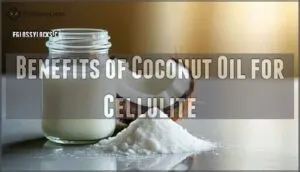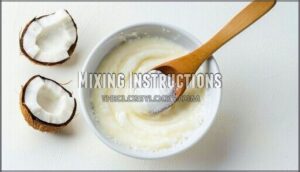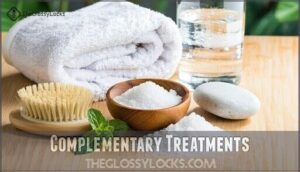This site is supported by our readers. We may earn a commission, at no cost to you, if you purchase through links.
 You can create a simple scrub by mixing half a cup of melted coconut oil with a quarter cup of baking soda.
You can create a simple scrub by mixing half a cup of melted coconut oil with a quarter cup of baking soda.
This combination works because coconut oil moisturizes while baking soda gently exfoliates dead skin cells.
Apply the paste to damp skin using circular motions, focusing on areas where cellulite appears most visible.
Massage for two to three minutes, then rinse with warm water.
The coconut oil helps improve skin texture and hydration, while baking soda removes surface buildup that can make cellulite more noticeable.
However, results vary substantially between individuals, and this method won’t eliminate cellulite completely.
Understanding proper application techniques and realistic expectations makes all the difference.
Table Of Contents
- Key Takeaways
- How to Use Coconut Oil and Baking Soda for Cellulite?
- Understanding Cellulite and Its Causes
- Benefits of Coconut Oil for Cellulite
- Baking Soda’s Role in Cellulite Reduction
- DIY Coconut Oil and Baking Soda Scrub Recipe
- Incorporating The Scrub Into Your Routine
- Frequently Asked Questions (FAQs)
- Can baking soda help cellulite?
- Can I mix baking soda with coconut oil?
- Does coconut oil help with cellulite?
- Can coconut oil remove cellulite?
- Does baking soda break down cellulite?
- Can you mix baking soda and coconut oil?
- Can cellulitis be treated with home remedies?
- How to get rid of cellulite with coconut oil?
- Does baking soda reduce cellulite?
- Can coconut oil cause skin allergies?
- Conclusion
Key Takeaways
- Mix equal parts wisely: You’ll create an effective scrub by combining 1/2 cup of melted coconut oil with 1/4 cup of baking soda, then massage it onto damp skin using circular motions for 2-3 minutes before rinsing.
- Set realistic expectations: You won’t eliminate cellulite completely with this method, but you’ll improve skin texture and temporarily reduce the dimpled appearance through gentle exfoliation and moisturization.
- Use it strategically: You’ll get the best results by applying the scrub 1-3 times weekly during your evening routine, starting with once per week to test your skin’s tolerance.
- Watch for skin reactions: You’ll need to patch-test first if you have sensitive skin, as baking soda can disrupt your skin’s pH balance and cause irritation with overuse.
How to Use Coconut Oil and Baking Soda for Cellulite?
Breaking free from cellulite concerns starts with understanding what actually works. Coconut oil cellulite treatments combined with baking soda cellulite remedies create an effective cellulite reduction approach.
Mix 1/2 cup coconut oil with 1/4 cup baking soda until smooth. Massage this scrub onto damp skin using circular motions, targeting cellulite-prone areas, then rinse with warm water.
Create a smooth paste, massage in circles on damp skin, then rinse for silky results.
Coconut oil benefits include deep moisturization while baking soda uses extend to gentle exfoliation. Using these ingredients can also provide natural exfoliation properties that gently remove dead skin cells.
Use 1-3 times weekly for Expected Results. Sensitive Skin types should patch-test first. While Cellulite Myths suggest instant fixes, Long-Term Effects require consistency. Consider Scrub Alternatives if irritation occurs.
Understanding Cellulite and Its Causes
You’ll want to understand what creates those dimpled skin areas before trying coconut oil and baking soda treatments.
Cellulite occurs when fat cells push against your skin while connective tissue bands pull downward, creating the characteristic bumpy appearance.
That affects about 85% of women, making it a common issue related to cellulite.
Hormonal and Genetic Factors
Your family history plays a bigger role in cellulite development than you might think.
Genetic predisposition determines how your body stores fat and produces collagen. Hormonal imbalance, especially estrogen influence during puberty and menopause, weakens connective tissues.
These hormonal factors affect collagen production, making skin more prone to dimpling. Understanding these genetic factors helps explain why coconut oil cellulite and baking soda cellulite treatments work differently for everyone.
Fat Distribution Patterns
Your body’s fat distribution patterns play a vital role in cellulite formation, with certain areas becoming more susceptible based on your unique genetic blueprint.
Understanding these patterns helps explain why cellulite appears differently across individuals and why coconut oil and baking soda treatments may work better on specific areas.
Three key factors influence fat distribution patterns:
- Gender Differences – Women typically store fat in thighs and buttocks, while men accumulate it around the abdomen
- Age Influence – Metabolism slows with age, altering where your body deposits fat
- Genetic Predisposition – Your family history determines your body composition and regional variations in fat storage
Skin Structure Changes
Your skin’s architecture shifts over time, directly impacting cellulite visibility.
Collagen breakdown weakens connective tissues, while reduced dermal thickness allows fat cells to push through more easily.
Epidermal health deteriorates as fat cell size increases and circulation slows.
These structural changes reduce skin firmness, making dimples more pronounced.
Understanding this process helps you target cellulite effectively with treatments like coconut oil and baking soda scrubs.
Benefits of Coconut Oil for Cellulite
You’ll find coconut oil offers several specific benefits when targeting cellulite through its anti-inflammatory and moisturizing properties.
This natural ingredient hydrates your skin while potentially reducing the dimpled appearance that makes cellulite visible, utilizing its moisturizing properties.
Anti-inflammatory Properties
Coconut oil’s medium-chain fatty acids deliver powerful antiinflammatory benefits that can help calm irritated skin around cellulite areas.
These natural compounds work to reduce redness and swelling while protecting against harmful microorganisms.
The oil’s skin soothing properties may minimize the dimpled appearance by addressing inflammation causes beneath the surface.
When combined with baking soda, these coconut benefits create an effective alternative remedy for smoother-looking skin.
Moisturizing Effects
The moisturizing magic of coconut oil works wonders for your skin’s appearance and feel.
This natural powerhouse delivers deep hydration that can transform how your skin looks and feels:
- Boosts skin elasticity – keeping your skin supple and resilient
- Locks in hydration levels – preventing moisture loss throughout the day
- Helps with masking dimples – creating a smoother surface appearance
- Improves smoothing texture – enhancing overall skin health naturally
Potential Drawbacks
Despite coconut oil’s moisturizing benefits, you’ll face real challenges with regular use.
This natural remedy can trigger pore clogging and skin irritation, especially if you have sensitive or acne-prone skin.
Baking soda creates pH imbalance issues that may worsen over time.
Allergic reactions aren’t uncommon either.
Consider your usage frequency carefully—overdoing it amplifies these risks.
Potential Pitfalls Coconut Oil Baking Soda
Clogging
Irritation
Skin damage
Always patch-test before committing.
Baking Soda’s Role in Cellulite Reduction
Baking soda acts as a natural exfoliant that removes dead skin cells and improves blood circulation in cellulite-prone areas.
You’ll need to monitor your skin’s pH balance carefully, as baking soda’s alkaline properties can cause irritation if you use it too frequently, which is why it’s essential to be mindful of its application to avoid any potential irritation.
Exfoliation Benefits
Baking soda’s gritty texture works like a gentle sandpaper on your skin, promoting skin cell turnover that reveals fresher layers beneath.
When you massage this DIY scrub onto cellulite-prone areas, you’re kickstarting circulation improvement that helps break down stubborn fat deposits.
The exfoliation process doesn’t just smooth bumpy skin—it creates pathways for better product absorption.
Your coconut oil penetrates deeper when dead cells aren’t blocking the way.
This scrubbing action also stimulates lymphatic drainage, helping your body flush out toxins that contribute to cellulite formation.
The texture refinement you’ll notice comes from consistent use, but don’t overdo it.
Twice weekly keeps your skin happy while delivering results you can actually see and feel.
PH Balance Considerations
While exfoliation benefits are clear, understanding your skin’s acidity becomes essential when using baking soda for cellulite reduction.
Baking soda’s alkalinity can disrupt your skin’s natural pH balance, potentially compromising its protective barrier.
Your skin normally maintains a slightly acidic environment, but baking soda’s high alkaline content can throw this delicate balance off-kilter.
Baking soda can also offer benefits for body care, such as soothing sunburn.
Here’s how to protect your pH balance when using coconut oil and baking soda:
- Test small areas first – Apply the mixture to a patch of skin and wait 24 hours to check for reactions
- Limit frequency – Use the scrub only 1-2 times weekly to prevent over-alkalizing your skin
- Follow with toner – Apply a pH-balancing toner after treatment to restore your skin’s natural acidity
Sensitive skin requires extra caution with these neutralizing after-effects to avoid long-term impacts.
Potential Skin Irritation
Your skin deserves gentle care when using baking soda scrubs.
Patch testing is essential for those with sensitive skin – apply a small amount first to check for allergic reactions.
Watch for redness concerns and irritation symptoms like burning or stinging.
The high pH balance of baking soda can trigger reactions, so dilute it properly with coconut oil before application.
DIY Coconut Oil and Baking Soda Scrub Recipe
You’ll need just three simple ingredients to create an effective cellulite-fighting scrub at home.
This straightforward recipe combines coconut oil’s moisturizing properties with baking soda’s exfoliating action to target dimpled skin areas.
Ingredients List
Creating your DIY cellulite scrub requires minimal preparation and common household items.
You’ll discover the power of natural remedies with these essential components:
- Coconut oil (1/2 cup) – Choose virgin or organic oil types for maximum benefits
- Baking soda (1/4 cup) – Acts as the primary exfoliant
- Essential oils (5-10 drops) – Optional for fragrance and added skin benefits
- Sugar options or coffee grounds (1/4 cup) – For enhanced exfoliation when desired
Consider different product options when selecting your coconut oil.
Mixing Instructions
Now that you’ve gathered your ingredients, it’s time to create your DIY cellulite scrub.
Combine 1/2 cup coconut oil with 1/4 cup baking soda in a medium bowl. Use a wooden spoon or silicone spatula as your mixing tools to achieve proper texture consistency.
If your coconut oil feels solid, warm it slightly between your palms first. Blend until you reach a smooth, paste-like mixture with balanced ingredient ratios.
Remember that baking soda can help with natural exfoliation properties, which is an important aspect of this DIY scrub and its natural benefits.
Application Method
Your DIY scrub awaits proper application method to tackle cellulite effectively. Start with damp, clean skin for ideal absorption.
Using massage techniques with circular motions, work the coconut oil and baking soda mixture into problem areas. Focus on scrub consistency – it should glide smoothly without excessive grittiness.
Evening works best for overnight recovery. Rinse thoroughly, then follow post-application care with moisturizer for enhanced results.
Some find that using specific massage tools enhances their routine.
Incorporating The Scrub Into Your Routine
You’ll get the best results by using this scrub 1-3 times weekly, starting with once per week to test your skin’s tolerance.
Apply the mixture during your evening routine after showering, when your skin can absorb the ingredients and recover overnight.
Frequency of Use
To maximize the benefits of using coconut oil and baking soda for cellulite, follow an ideal frequency that suits your skin.
- Start with 1-2 times weekly, then adjust to 2-3 times if no skin irritation occurs.
- Apply for 5-10 minutes, increasing as your skin tolerates.
Pair with healthy habits like drinking water, exercising, and eating well to boost results.
Consistency is your key to visible long-term effects, and it is crucial to remember that patience and persistence are vital for achieving the desired outcome with coconut oil.
Best Time to Apply
In the context of timing your coconut oil and baking soda scrub for cellulite, consistency matters more than Night vs. Morning preferences.
Post-Shower Application maximizes Skin Absorption Rate when pores are open and circulation is elevated.
For those seeking additional options, a cellulite scrub recipe can be easily found online.
Some prefer Pre-Workout Use to boost blood flow, but avoid sun exposure afterward since baking soda increases photosensitivity.
Establish a Consistency Schedule that fits your lifestyle.
Complementary Treatments
Beyond timing, you’ll want to amplify your coconut oil and baking soda scrub with supporting treatments.
Dry brushing before application boosts circulation and prepares skin for better absorption. Follow up with massage techniques using circular motions to stimulate lymphatic drainage.
Hydration importance can’t be overstated—drink plenty of water daily. Dietary changes focusing on antioxidants and lean proteins support skin health from within.
For ideal skin health, consider incorporating a gentle skincare routine into your daily life. Consider alternating your natural remedies with gentle topical creams for enhanced cellulite reduction results.
Frequently Asked Questions (FAQs)
Can baking soda help cellulite?
Baking soda won’t magically erase your dimples overnight, but it can help.
You’ll improve blood circulation and exfoliate dead skin when massaging it gently.
This creates smoother-looking skin that temporarily reduces cellulite’s appearance.
Can I mix baking soda with coconut oil?
Yes, you can safely mix baking soda with coconut oil to create an effective cellulite scrub.
This combination exfoliates dead skin cells while moisturizing, potentially improving circulation and reducing cellulite’s dimpled appearance.
Does coconut oil help with cellulite?
Coconut oil can help reduce cellulite’s appearance by hydrating your skin and improving elasticity.
While it won’t eliminate cellulite completely, regular massage with coconut oil may smooth dimples and enhance overall skin texture naturally, which can help improve the appearance.
Can coconut oil remove cellulite?
Sadly, coconut oil can’t eliminate cellulite entirely.
While it hydrates skin and may temporarily smooth dimples, making them less noticeable, you’ll need consistent lifestyle changes including exercise and proper diet for lasting results.
Does baking soda break down cellulite?
Scientific evidence doesn’t support baking soda’s ability to break down cellulite.
While it can exfoliate dead skin cells and temporarily improve circulation, you won’t see lasting cellulite reduction from baking soda alone.
Can you mix baking soda and coconut oil?
You can definitely mix baking soda and coconut oil together.
This combination creates an effective scrub that exfoliates skin while moisturizing.
The mixture helps improve circulation and may reduce cellulite’s appearance when used regularly.
Can cellulitis be treated with home remedies?
No, you shouldn’t treat cellulitis with home remedies.
This serious bacterial skin infection requires immediate medical attention and prescription antibiotics.
Delaying proper treatment can lead to dangerous complications like blood poisoning.
How to get rid of cellulite with coconut oil?
You can massage pure coconut oil directly into cellulite-prone areas daily.
Its moisturizing properties improve skin texture and elasticity, potentially reducing dimpling appearance.
Combine with regular exercise and hydration for better results.
Does baking soda reduce cellulite?
Baking soda’s exfoliating properties can temporarily improve circulation and skin texture, potentially making cellulite less visible.
However, it doesn’t eliminate cellulite permanently.
You’ll need consistent use alongside healthy lifestyle changes for noticeable results.
Can coconut oil cause skin allergies?
Like a double-edged sword, coconut oil can indeed trigger skin allergies in some people.
You might experience redness, itching, or breakouts, especially if you’re sensitive or acne-prone.
Always patch-test before full application.
Conclusion
While expensive treatments promise dramatic results, learning how to use coconut oil and baking soda for cellulite offers an affordable alternative.
This simple scrub won’t eliminate cellulite completely, but it can improve skin texture through gentle exfoliation and moisturization.
You’ll need realistic expectations and consistent application to see modest improvements.
Remember that cellulite affects most women regardless of body type, so focus on skin health rather than perfection when incorporating this DIY treatment.
- https://www.medicalnewstoday.com/articles/321180
- https://www.healthshots.com/beauty/natural-cures/5-home-made-scrubs-to-reduce-cellulite-naturally/
- https://hollywoodlife.com/2017/03/14/at-home-cellulite-treatment-how-to-get-rid-of-it/
- https://www.huffingtonpost.com/entry/myths-about-cellulite_us_559e90b2e4b05b1d028fca2a
- https://www.medicinenet.com/cellulite/article.htm












